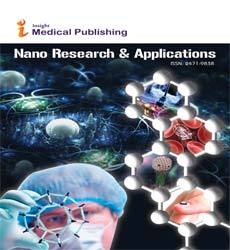Editorial Note on Nanotechnology in Cancer
Abhilasha Vemula
DOI10.36648/2471-9838.21.7.33
Abhilasha Vemula
Department of Biotechnology, Osmania University, Hyderabad, Telangana, India
Corresponding author: Abhilasha V
Received: July 20, 2020; Accepted: July 25, 2021; Published: July 30, 2021
Citation: Abhilasha V (2021) Editorial Note on Nanotechnology in Cancer. Nano Res Appl Vol.7 No.7:33
Human cells are a hundred to ten thousand times smaller than nanoscale devices. They're about the same size as enzymes and receptors, which are large biological molecules ("biomolecules"). Hemoglobin, the molecule that transports oxygen in red blood cells, has a diameter of about 5 nanometers. Nanoscale devices with a diameter of less than 50 nanometers can easily access most cells, whereas those with a diameter of less than 20 nanometers can easily escape blood arteries as they circulate through the body. Nanoscale devices can easily interact with biomolecules on the surface and inside cells due to their small size. They have the potential to detect disease and deliver treatment in previously unimagined ways by gaining access to so many areas of the body.
At the nanoscale, biological processes take place, including those that are vital for life and those that lead to cancer. As a result, we are made up of a slew of biological nano-machines. Researchers can examine and change macromolecules in real time and at the earliest stages of cancer progression thanks to nanotechnology. Nanotechnology has the potential to detect cancer-related chemicals quickly and sensitively, allowing scientists to discover molecular alterations in a small percentage of cells. Nanotechnology has the ability to create completely new and very effective medicinal treatments.
Finally, and perhaps most importantly, the ability of nanoscale materials to be easily functionalized and tuned; their ability to deliver and/or act as therapeutic, diagnostic, or both; and their ability to passively accumulate at the tumour site, to be actively targeted to cancer cells, and to be delivered across traditional biological barriers in the body such as dendritic cells.
A good cancer medicine delivery system should achieve substantial tumour accumulation while sparing the surrounding healthy tissues. For tumours, the Enhanced Permeability and Retention [EPR] effect (passive localisation of numerous medications and drug carriers due to extravasation through leaky vasculature) works particularly effectively. As the tumour mass expands, a network of blood arteries must spread swiftly to provide the tumour cells' oxygen and food requirements. Angiogenesis (abnormal and poorly controlled vessel formation) develops in vessel walls with big holes (40 nm to 1 um), allowing relatively large nanoparticles to extravasate into tumour masses. Due to the lack of a functioning lymphatic system in a rapidly developing tumour mass, clearance of these nanoparticles is hindered, which increases the buildup. Nanoparticles larger than 8 nm (between 8 and 100 nm) can passively target tumours by freely passing through large pores and achieving increased intratumoral concentration because to the EPR effect. To assure significant drug accumulation and hence improve treatment success, the majority of contemporary nanomedicines for solid tumour treatment rely on the EPR effect. This drug delivery technique is known as passive targeting since it does not target cell types that express the desired targeting ligand.
Passive targeting necessitates a long-circulating drug delivery system to allow adequate levels of drug to reach the tumour site for EPR effect to occur. To create nano-drugs that stay in the bloodstream longer, the surface of the nanoparticles can be modified with water-soluble polymers such as polyethylene glycol (PEG); PEG is commonly employed in pre-clinical research facilities to make water-insoluble nanoparticles water-soluble. Clinically, PEG-coated liposomal doxorubicin (Doxil) is utilised to promote passive tumour accumulation in breast cancer patients. Nano-drugs with a neutral or positive charge are likely to have a longer plasma half-life, as the in vivo monitoring system for macromolecules (i.e., scavenger receptors of the reticuloendothelial system, RES) allegedly exhibited faster uptake of negatively charged nanoparticles.
Open Access Journals
- Aquaculture & Veterinary Science
- Chemistry & Chemical Sciences
- Clinical Sciences
- Engineering
- General Science
- Genetics & Molecular Biology
- Health Care & Nursing
- Immunology & Microbiology
- Materials Science
- Mathematics & Physics
- Medical Sciences
- Neurology & Psychiatry
- Oncology & Cancer Science
- Pharmaceutical Sciences
